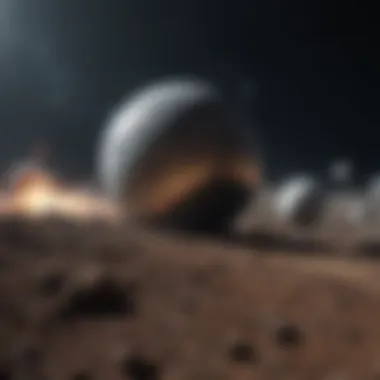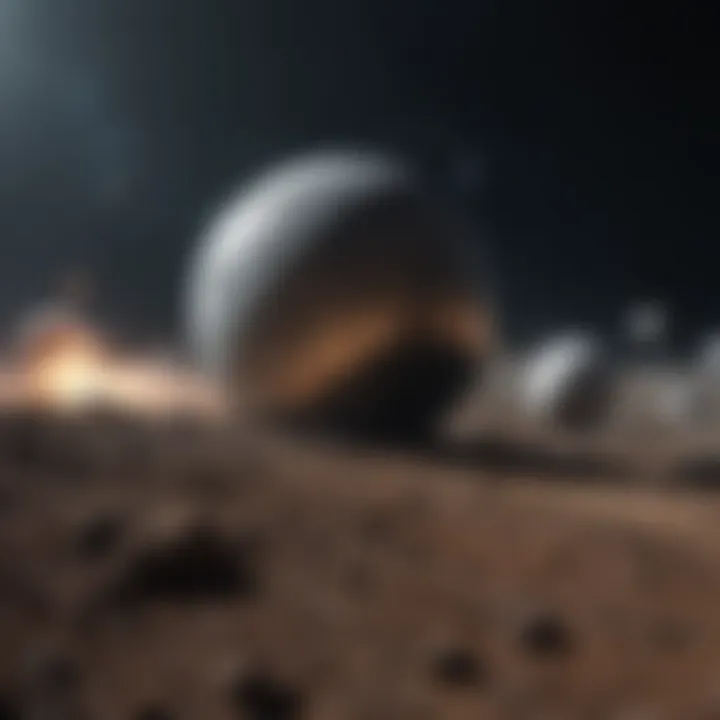Milestones of Humanity's Journey to the Moon


Intro
The story of humanity's journey to the Moon is as complex as it is inspiring. Captivating hearts and minds, it shaped an era defined by ambition and discovery. Examining the milestones from early exploration to the historic Apollo 11 mission helps us appreciate not just the essence of the achievement, but also the technological, political, and social undercurrents that drove it.
The Moon, that silvery orb in the night sky, has long captivated human imagination. Throughout history, luminaries like Galileo and Copernicus pondered its mysteries. However, it was not until the mid-20th century that the dream of touching our celestial neighbor began to materialize. The race was on, spurred by geopolitical tensions and a quest for national prestige.
This article takes a closer look at the defining moments that paved the way for that monumental leap. From the technical milestones in engineering and space travel to the stirring tales of key figures, every aspect works together in the tapestry of this historical event.
Recent Advances
Latest Discoveries
As we reflect on the past, it’s essential to connect older endeavors with recent insights. The analysis of lunar samples returned by the Apollo missions continues to yield revelations. For instance, findings in 2020 discovered the presence of water in unusual locations on the Moon. This has turned the spotlight back onto lunar exploration, hinting at potential long-term human habitation.
"The Moon is not just a destination; it's a stepping stone for future exploration of Mars and beyond."
Technological Innovations
The Apollo missions weren't just about putting a man on the Moon; they represented a profound leap in technology. The spacecraft's onboard computers were groundbreaking for their time, utilizing what we would now consider rudimentary programming techniques.
- Navigation Systems: The inertial navigation systems developed in the 1960s laid the groundwork for modern applications.
- Communication: The ability to communicate live with Earth was a feat in itself, employing technologies like transponders and high-gain antennas.
- Life Support Systems: Unique technologies for sustaining human life in space were pivotal, sparking developments in our understanding of environmental control systems.
These innovations didn’t just propel humanity outward; they influenced numerous sectors on Earth, driving advancements in computing, telecommunications, and engineering.
Methodology
Research Design
The study of the journey to the Moon involves a multidisciplinary approach, weaving together history, engineering, and politics. This synthesis allows for an enriched understanding of the broader implications of space exploration on society.
Data Collection Techniques
Historical accounts and scientific journals serve as primary sources, allowing researchers to trace the evolution of technology and strategic choices during the Space Race. Additionally, interviews with engineers and astronauts provide a firsthand perspective on the challenges and triumphs experienced during those pivotal missions.
By examining the blend of technical detail and narrative, it becomes clear that each element played a crucial role in shaping the course of human exploration, helping us comprehend not just how we got there, but why it mattered.
Preface to Lunar Exploration
The desire to explore beyond our terrestrial confines is as old as humanity itself. The exploration of the Moon marks a significant chapter in this ongoing tale of curiosity and ambition. Understanding lunar exploration helps tether our gaze to the stars while grounding us in our history. This section will illustrate how the Moon has been a focal point for human endeavors and reflect on the broader implications of these aspirations.
Historical Context
From ancient times, when early civilizations gazed at the bright orb in the night sky, the Moon has held a sense of mystery and emotion. Cultures throughout history, from the Sumerians to the Greeks, have ascribed various meanings to the Moon. It served as a calendar for agricultural societies and influenced mythologies and religions. Yet, this fascination would eventually evolve into a more ambitious pursuit.
The late 19th and early 20th centuries saw a surge in interest in the heavens, coinciding with technological advancements. Publications like Jules Verne's "From the Earth to the Moon" inspired a generation to dream of lunar travel. By the mid-20th century, persistent scientific inquiry led to more structured efforts to explore the Moon. The Soviet Union's Luna program and NASA's Mercury missions began to lay foundational knowledge about space travel and planetary science.
Aspirations Beyond Earth
The Moon is often seen as the gateway to the cosmos. The idea took shape that reaching for the Moon could pave the road for future manned missions to Mars and beyond. This aspiration was intensified during the Cold War Era; lunar exploration became a symbol of national pride. Both superpowers strived not only for scientific achievement but also to showcase technological superiority.
Several key factors fueled these ambitions:
- Scientific Inquiry: The Moon offers crucial insights into the origins of our solar system. Its surface holds records of cosmic events unseen on Earth.
- Technological Development: Planning missions to the Moon accelerated innovations in rocket technology, materials science, and computer systems.
- Cultural Significance: Achieving a lunar landing became a shared human experience, uniting millions across the globe as they watched the event unfold.
"The Moon is a friend, not a foe. Its allure ignites curiosity and ambitions long after we set foot on its surface."
In sum, the story of lunar exploration is woven deeply into the fabric of human aspiration. It represents our eternal quest for knowledge and understanding, a journey that continues to hold relevance as we look out to the stars.
The Space Race: A Global Rivalry
The Space Race serves as one of the pivotal events of the 20th century, shaping not just technological innovations, but also international relations and national identities. This intense rivalry was not merely about demonstrating superiority in science and technology; it was also deeply woven into the broader geopolitical context of the Cold War. The competition between the United States and the Soviet Union ushered in an era of rapid advancements, each nation eager to stake its claim as the leader in space exploration.


As the spotlight of the world turned towards the stars, the Space Race embodied the aspirations and anxieties of a generation. It marked a critical juncture where success in space could translate into dominance on Earth, affecting everything from military strategy to educational priorities. Understanding this rivalry is crucial for grasping the motivations and consequences of the efforts that led to humanity's first moon landing.
The United States vs. The Soviet Union
The roots of the Space Race can be traced back to the aftermath of World War II, when both the United States and the Soviet Union emerged as superpowers. The launching of Sputnik in 1957 by the Soviet Union shocked the world, representing a significant advancement in space technology. It propelled the United States into a frenzy of activity aimed at catching up, leading to the establishment of NASA in 1958.
The era was characterized by a series of milestones that showcased each country's technological prowess:
- Vostok 1: In 1961, Yuri Gagarin became the first human to orbit the Earth, further intensifying American fears about Soviet capabilities.
- Mercury and Gemini Programs: The U.S. responded with its own manned missions, with John Glenn orbiting the Earth in Mercury-6 and the Gemini missions paving the way for Lunar exploration.
- Apollo 11: Eventually, America claimed the ultimate victory with the moon landing in 1969, marking a decisive moment in this global competition.
This relentless pursuit also had profound implications on science, education, and public policy. Funds funneled into scientific research catalyzed technological breakthroughs that are still relevant today.
Political Implications
The Space Race was not just about technology; it was closely tied to political power and propaganda. Each successful mission became a source of national pride, a way of showcasing the strength and ingenuity of each nation to its citizens and the world.
Moreover, the competition led to significant investments in education and advanced research. For instance:
- The U.S. implemented programs that aimed to enhance math and science education, resulting in a generation of skilled professionals.
- The Soviet Union, while initially leading in achievements, faced challenges with bureaucratic inefficiency and a lack of public engagement in scientific endeavors.
The political fallout of the Space Race was far-reaching. It solidified the ideological divide between capitalism and communism. The moon landing was seen not only as a triumph of human ingenuity but also as a symbolic defeat for the Soviet model.
"The moon landing was about more than just space; it demonstrated how far America had come in the face of rivalry," remarked noted historian Susan Foreman.
Technological Innovations Paving the Way
The journey to the Moon cannot be understood without acknowledging the profound technological innovations that paved its path. These advancements weren't merely tools; they were the backbone of a newfound capability in space exploration. Innovations in various fields inspired confidence, reshaping both public and governmental perspectives on space travel. The significance of these technologies lies not only in their immediate applications but also in how they laid the groundwork for future endeavors beyond our planet.
Advancements in Rocketry
Rocketry saw transformative developments during the years leading up to the Moon landing. The early designs, such as the V-2 rocket from World War II, primarily aimed at military applications. However, engineers and scientists quickly understood the potential of these rockets for non-military purposes. The transition from these war-driven constructs to the sophisticated spacecraft capable of lunar missions involved a blend of creativity and scientific rigor.
One notable advancement was the F-1 rocket engine, which powered the Saturn V. This powerful engine relied on the unique mixture of RP-1 (a type of kerosene) and liquid oxygen, resulting in an unprecedented thrust. Such advancements elevated not just the capacity to reach the Moon but also enhanced efficiency and safety. Additionally, materials science also witnessed progress, with lightweight but incredibly strong materials becoming integral in constructing rocket bodies. These decisions were not random but stemmed from years of trial and error, emphasizing the necessity for incremental improvements in the face of monumental tasks like Moon landings.
- Increased payload capacity enabled sending larger spacecraft and equipment.
- Innovations in materials reduced weight, enhancing fuel efficiency.
- Precision engineering ensured improved flight stability and guidance.
Indeed, rocketry represented a triumph of human ingenuity, with highly skilled engineers working tirelessly to perfect these engines. Without these advancements, the very idea of a Moon mission would have remained a nebulous dream.
Computational Progress in Space Navigation
The leap in computational capabilities has redefined what is possible in space exploration. Early navigation systems were rudimentary at best, relying heavily on celestial alignments and manual calculations. Yet as the 1960s dawned, the advent of computers sparked a revolution in how missions were planned and executed.
The mere thought of sending humans into space demanded precise navigation, an intricate dance of geometry and physics that had to account for variables like velocity, gravitational slingshots, and orbital mechanics. The Apollo Guidance Computer (AGC) came as a stellar breakthrough in this landscape. It was a compact, lightweight solution that could compute the spacecraft’s trajectory in real-time, an incredible feat at a time when computers were not as commonplace as they are now.
While navigating a spacecraft toward the Moon, the AGC had to perform calculations that would ensure the craft entered lunar orbit at the correct angle.
"It was nothing short of audacious to imagine sending a computer to the Moon when computers back home were still evolving."
The combination of its input from astronauts and the ability to process vast amounts of data instantaneously was critical. The approach helped create a smoother trajectory, maintaining communication with mission control back on Earth.
- The role of software advancement cannot be understated in altering spacecraft autonomy
- Real-time adjustments during flight were facilitated by robust computational power
- Enhanced data processing improved mission planning and risk reduction
The transformation from rudimentary tools to sophisticated computing systems exemplifies the technological symbiosis that made the Moon landing possible. Every achievement, big or small, combined to push the boundaries of what humanity could achieve. The interplay between rocketry and computing will continue to resonate in future space explorations, further establishing our place in the cosmos.
Key Missions Leading to the Moon Landing
The leap to the Moon wasn't just a single monumental event; it was the culmination of several key missions that paved the way for humanity to touch the lunar surface. These missions laid the groundwork for technological advancements, trained astronauts, and provided critical data about space travel. An understanding of these missions reveals the complexities and risks undertaken by the scientists and engineers dedicated to this quest.
The Mercury Program
The Mercury Program, which commenced in 1958, was the United States' first series of manned spaceflights. The primary goal here was to test if humans could survive in space travel. Each flight was carefully designed to gather key insights about the physical effects of space on astronauts and the dynamics of spacecraft operation.
The program saw six manned flights, with achievements including the first American, Alan Shepard, to soar into space and John Glenn, who became the first American to orbit the Earth.
While the Mercury missions didn't venture to the Moon directly, they established foundational knowledge in navigation, communication, and life support systems. These elements would be critical for future missions, notably paving the way for deep-space ventures.
The Gemini Missions


Following Mercury, the Gemini Program ran from 1961 to 1966 and presented more complex challenges and objectives. This series focused on spaceflight techniques essential for lunar missions, including rendezvous and docking maneuvers, which allowed two spacecraft to join in orbit.
Gemini's achievements were impressive: astronauts spent extended periods in space—up to two weeks in some missions—acclimating to the conditions they would face on longer journeys.
Moreover, the missions helped develop critical staging technology for rockets and refined re-entry techniques that would later be vital for Apollo. These advancements weren't merely incremental; they were stepping stones that made the lunar goal seem increasingly achievable.
Apollo Program Overview
The Apollo Program, initiated in 1960, was the hallmark of American moon exploration. With a bold aim to land humans on the Moon, it spanned several missions all the way from Apollo 1 to Apollo 17. The Apollo era kicked off with a disaster in 1967 when a cabin fire during a pre-launch test tragically took the lives of three astronauts.
However, this setback ignited a renewed dedication to safety and innovation. Apollo 11, perhaps the most famous of the series, successfully executed the first manned lunar landing in 1969, with Neil Armstrong and Buzz Aldrin making history as they planted a flag on the Moon.
The Apollo missions delivered a wealth of scientific data and lunar samples, each providing insights into the Moon's geology, environment, and potential resources. Not only did they achieve national pride, but they also expanded our understanding of the cosmos.
"The eagle has landed." - Neil Armstrong, announcing a successful Moon landing.
In hindsight, these missions were more than just technological undertakings; they were a reflection of human curiosity and the unyielding spirit of exploration. The Mercury, Gemini, and Apollo missions united science and humanity’s aspirations, turning dreams of lunar exploration into reality.
Apollo Eleven: The Landmark Mission
Apollo Eleven stands as one of the most significant milestones in the saga of space exploration. This mission not only marked humanity's first steps on the lunar surface but also served as a touchstone for scientific achievement, international prestige, and even national identity. The successful landing on the Moon was a culmination of decades of rigorous research, bold experimentation, and unwavering human spirit.
The importance of Apollo Eleven extends beyond the mere act of landing. It was a moment that encapsulated the best of human ambition and ingenuity. The mission fulfilled President John F. Kennedy's 1961 pledge to land a man on the Moon by the end of the decade and return him safely to Earth. This feat shifted the paradigm of what humans believed was possible, providing a new frontier for exploration and a shared experience that united people across the globe in awe and wonder.
Crew Members and Their Roles
Each crew member on Apollo Eleven played a crucial role in ensuring the mission's success. The team consisted of three highly trained astronauts:
- Neil Armstrong: As the mission commander, Armstrong was historically significant. He not only piloted the command module and lunar module, but he also became the first human to set foot on the Moon, uttering the now-famous words, "That's one small step for [a] man, one giant leap for mankind."
- Edwin "Buzz" Aldrin: As the lunar module pilot, Aldrin's responsibilities included operating the lunar module during its descent and ascent from the Moon. He became the second person to walk on the lunar surface shortly after Armstrong, contributing significantly to the mission's exploration activities.
- Michael Collins: Serving as the command module pilot, Collins remained in orbit around the Moon while Armstrong and Aldrin explored its surface. His role was pivotal, as he maintained communications with mission control and ensured that the lunar module could rendezvous with the command module for the return to Earth.
This collaboration among the crew members exemplified teamwork in high-stakes environments, showcasing their individual skills while contributing to a collective goal.
Launch and Journey to the Moon
The launch of Apollo Eleven took place on July 16, 1969, from the Kennedy Space Center in Florida. The Saturn V rocket was an engineering marvel of its time, towering at 363 feet with a liftoff mass of approximately 3 million pounds. After a successful countdown, the rocket lifted off, carrying the hopes of a nation and the world.
As the spacecraft traveled approximately 240,000 miles to the Moon, the journey was fraught with challenges. The crew members had to navigate complex orbital maneuvers and experienced the unique stresses of space travel. They faced cosmic radiation, microgravity, and isolation, yet their training and camaraderie helped maintain their focus.
Once they entered the Moon's orbit, the mission shifted gears. Armstrong and Aldrin prepared for lunar landing, while Collins orbited above in the command module, ready to assist during the next critical phase. This meticulous planning exemplified human ingenuity and the capacity to overcome obstacles in the face of uncertainty.
Landing on the Lunar Surface
The Luna module, nicknamed "Eagle," separated from the command module on July 20, 1969, initiating the descent to the lunar surface. As they neared landing, the computer guiding the lunar module encountered issues, prompting Armstrong to take manual control to navigate a rocky terrain. His calmness under pressure illustrates a profound depth of training and preparation.
With a final touchdown in the Sea of Tranquility, the Eagle landed at 2:56 UTC. Armstrong and Aldrin conducted their exploration, collecting samples and conducting experiments. They planted the American flag, capturing the moment as a symbol of achievement for humankind. The landing was more than a scientific endeavor; it was a collective moment embedded in the human experience, representing an indomitable quest for knowledge and adventure.
"The Eagle has landed."
— Neil Armstrong
This powerful statement marked not only the successful landing but also a fundamental shift in humanity's understanding of its place in the universe. As Apollo Eleven demonstrated, the journey to the Moon was not just about physics and engineering; it was a narrative woven through human ambition, technological prowess, and the spirit of exploration.
Scientific Discoveries from the Moon
The Lunar expeditions have enriched our understanding of not just the Moon but also broader cosmic phenomena. The findings made during various Apollo missions, especially Apollo 11, have had lasting impacts on multiple scientific domains. Here we delve into the geological insights and astronomical implications that arose from studying the Moon's surface and environment.
Geological Findings
When astronauts first set foot on the lunar surface, they collected regolith samples—essentially, the Moon's dirt and rock. These samples were a treasure trove of information. Scientists discovered that the Moon's crust is remarkably older than much of the Earth's surface; some samples date back to nearly 4.5 billion years. This time capsule provides clues about the early solar system and planetary formation.
In particular, the lunar mare, the dark basaltic plains on the Moon, revealed much about volcanic activities in its past. By studying these differences, geologists could infer the Moon's thermal history and its geological evolution over billions of years. The absence of water in the samples further emphasizes the dryness of the Moon—contrasting starkly with Earth.
"The Moon serves as a chronicle of our solar system's history, providing insights that cannot be recorded on Earth’s constantly changing surface."
Additionally, these geological studies have implications on potential resources for future expeditions. Helium-3, a rare isotope found in lunar regolith, has sparked interest for its potential use in nuclear fusion, hinting that the Moon might play a crucial role in future energy solutions.
Impact on Astronomy
The findings from lunar missions have also significantly influenced the field of astronomy. For one, the Moon provides a stable platform for observing celestial phenomena. Because it lacks an atmosphere, the lunar surface is free from many distortions and interferences prevalent on Earth. This clarity allows for improved observations of the universe.
Further, experiments conducted on the Moon, like the laser ranging experiment undertaken by Apollo 15, have enabled precise measurements of the Earth-Moon distance. Such data helps in understanding gravitational forces, which subsequently impacts various astrophysical theories.
Moreover, the Moon has served as a testing ground for new astronomical technology. Observatories built on the Moon could eventually be deployed to carry out more advanced observations, potentially revolutionizing the field.


In summary, the discoveries from the Moon have provided not only a foundational understanding of our closest celestial neighbor but have also opened doors to new avenues in both geology and astronomy. As we continue to explore the Moon, these revelations promise to expand our knowledge of the cosmos even further.
Cultural Impact of the First Moon Landing
The Moon landing in 1969 was not just a giant leap for mankind; it opened the floodgates to a plethora of cultural influences that echoed through different layers of society. The event transcended scientific and technological achievements, affecting art, music, film, literature, and even everyday conversations. In this section, we will delve into how the Moon landing shaped cultural narratives and aspirations across the globe.
Media Representation
The media played a pivotal role in framing the narrative surrounding the Moon landing. Everything from newspapers to television specials buzzed with excitement. When Neil Armstrong took that historic step onto the lunar surface, millions glued to their screens experienced a visceral connection to this achievement. The iconic images of the astronauts in their bulky suits, kicking up lunar dust and leaving the first footprints on another celestial body, became instant symbols of human ingenuity.
But the influence of media extended beyond mere reporting. It crafted a mythos around space exploration, turning astronauts into modern-day superheroes. Documentaries and films, such as From the Earth to the Moon or the movie First Man, created dramatized accounts that reflected both the triumphs and struggles of space travel. Some argue that this representation romanticized the journey, often glossing over the risks and challenges involved. Still, this theatrical portrayal undoubtedly spurred public interest and enthusiasm in science and technology among people who might otherwise have been indifferent.
Additionally, this media frenzy gave rise to a new genre of science fiction that took the imaginations of many to places beyond the Moon. Writers like Arthur C. Clarke and Isaac Asimov, for instance, found their works gaining unprecedented popularity. The Moon landing had not just set a milestone but had also become a creative springboard, inspiring a generation of thinkers and dreamers who looked to the stars.
Influence on Future Generations
The impact of the Moon landing is still evident today, especially in how it has shaped educational pursuits in science, technology, engineering, and mathematics, often referred to as STEM fields. This singular event ignited a passion for space exploration that has reverberated through the years. Schools and institutions began to incorporate more hands-on approaches in their curricula, encouraging students to explore the wonders of the universe.
Many young individuals, influenced by the Moon landing, have chosen career paths that align with astronomy and aerospace engineering. NASA and private space ventures are now more than just agencies; they are dream factories, providing opportunities for innovation and exploration. Moreover, the vision of humanity’s future in space is becoming a tangible concept rather than just a pipe dream.
This generational shift can also be seen in various cultural expressions. For example, films like Interstellar or Gravity have reignited conversations on human resilience and our quest for knowledge. The Martian, based on Andy Weir's novel, effectively captured the spirit of ingenuity, presenting a scenario that showcases the potential of human ingenuity when collectively facing an astronomical challenge.
"The Moon landing was more than an event; it fundamentally altered societal trajectories toward technology, education, and cultural perspective."
In summary, the cultural impact of the Moon landing remains profound, influencing not just how we view space but also how we envision our future. From the media’s portrayal that enshrined astronaut figures into the cultural consciousness to the motivation it provided for generations of innovators, this event serves as a crucial milestone not just in history but in the collective psyche of humanity.
Reflections on Human Endeavor
The journey to the Moon stands as a testament to human resilience, curiosity, and innovation. It’s a narrative that goes beyond mere scientific achievements. The lessons learned from space exploration encourage us to reflect on what it means to strive for greatness amid adversity. This section illuminates those fundamental reflections, emphasizing their significance for future explorations and our broader understanding of what humanity can accomplish when we aim high.
Lessons Learned from Space Exploration
Space exploration has taught us numerous lessons, many of which reverberate beyond the tiles of control rooms or launch sites. Here are a few key insights worth pondering:
- Collaboration is Crucial: The Apollo missions were not solely a US endeavor. International collaborations fostered advances in technology and knowledge-sharing. The expertise shared between nations shaped a more nuanced perspective of space science, uniting diverse skills toward a common goal.
- Uncertainty and Risk Management: Every step towards the Moon was riddled with uncertainties. Engineers and scientists had to devise ways to mitigate risks, from designing spacecraft to addressing the unknowns of space travel. Understanding and managing risks is vital, not only in space but also in any ambitious project.
- Adaptation and Problem Solving: The ability to adapt was crucial. Lessons from failures often led to breakthroughs. Consider the Apollo 13 mission's near-disastrous turn. The ingenuity demonstrated by the team converted potential disaster into a remarkable story of survival and problem-solving.
- Inspiration and the Human Spirit: Perhaps, most importantly, space exploration feeds the human spirit. It inspires generations to look beyond the mundane, encouraging dreams that propel society forward. The images of astronauts on the lunar surface remind each of us of our potential to transcend limitations.
The Future of Lunar Exploration
As we reflect on the past, it's equally crucial to gaze toward the horizon of lunar exploration. Future missions hold promise not just for scientific gains but also for humanity’s greater journey in understanding its place in the cosmos. Key elements shaping this future include:
- Sustainable Lunar Presence: NASA’s Artemis program aims to establish a sustainable human presence on the Moon by the end of the decade. This effort is crucial not only for scientific research but also for proving technologies essential for future Mars missions.
- Commercial Partnerships: The commercial space sector is gaining momentum. Companies like SpaceX and Blue Origin are working on technologies that can drastically reduce costs of lunar travel and support future lunar bases.
- International Collaboration: Just as the Apollo missions drew on international expertise, upcoming explorations involve collaboration across nations. Initiatives involving the European Space Agency and other entities signal a united front in lunar exploration, enhancing our collective potential.
- Scientific Endeavors: Future missions are expected to focus on exploring lunar resources, conducting geological research, and using the Moon as a platform for astronomical observations. The insights gained will not only uncover the Moon's mysteries but will also deepen our understanding of Earth’s formation and the solar system.
"The Moon is not just a destination; it’s a stepping stone for humanity as we explore beyond, unlocking doors to unknown realms and possibilities."
The End: The Legacy of Moon Landing
The legacy of the Moon landing is multifaceted, extending far beyond the immediate triumph of placing humans on the lunar surface. It embodies the spirit of human ingenuity and the relentless pursuit of knowledge. This achievement crystallized a moment in time where collective effort, national identity, and technological innovation intersected to shape the course of history.
The success of Apollo 11 galvanized interest in science and space exploration, inspiring generations. It demonstrated that people could achieve seemingly impossible tasks through collaboration and tenacity. Following the historic mission, many nations began to invest in space programs, recognizing the strategic advantages and potential benefits that come from exploring beyond our planet. Today, countries like China, India, and the United Arab Emirates have taken significant strides to extend their ventures into space, each carrying a piece of the legacy the Apollo missions established.
Ongoing Research and Development
The Moon landing opened a gateway to understanding not just the Moon, but the universe at large. Ongoing research continues to delve into lunar geology, searching for clues about Earth’s formation and the origins of life.
Advancements in technology have propelled research efforts:
- New robotic missions, like NASA's Lunar Reconnaissance Orbiter, provide detailed maps of the lunar surface.
- Innovative landers and rovers, such as China's Yutu-2, are crucial for examining the Moon's soil and rock composition.
The interest in establishing lunar bases brings in a new era of sustained research. Concepts for living quarters on the Moon could enable humans to live and work longer than ever before, creating possibilities for advanced studies in low-gravity environments. Researchers are also exploring the Moon��’s potential as a launch point for missions deeper into space, including Mars.
"The Moon is a stepping stone for humanity's future in the cosmos."
The Broader Implications for Humanity's Place in Space
Understanding our legacy from the Moon landing goes beyond scientific discoveries; it confronts profound questions about humanity's place in the universe. The venture to the Moon, once viewed as a nationalistic endeavor, has shifted toward viewing space as a common heritage of all mankind.
The implications of this shift can be elaborated upon as follows:
- International Collaboration: Future missions require global partnerships, as countries recognize the challenges and costs associated with space exploration are better faced together. Projects like the International Space Station are a testament to this collaborative spirit.
- Ethical Considerations: As we expand our activities in space, serious discourse around the ethical implications of exploration, resource utilization, and planetary protection is becoming essential. Who gets to decide how celestial bodies are used?
- Legacy of Inspiration: The Moon landing became a symbol of possibility. It showcased what humanity could achieve, encouraging young learners to pursue careers in science, technology, engineering, and mathematics (STEM).















